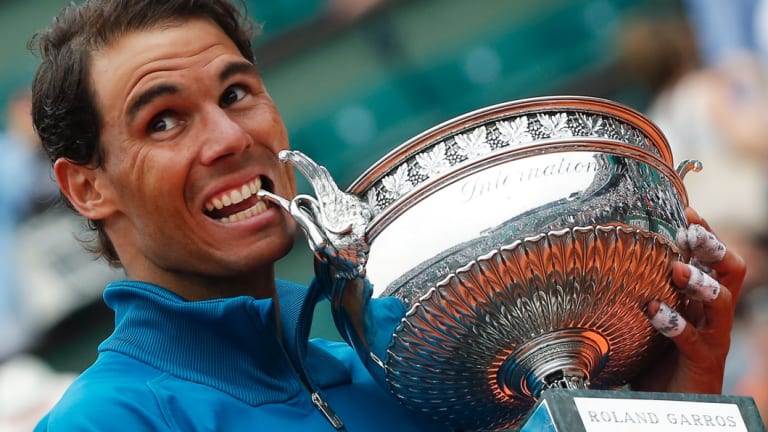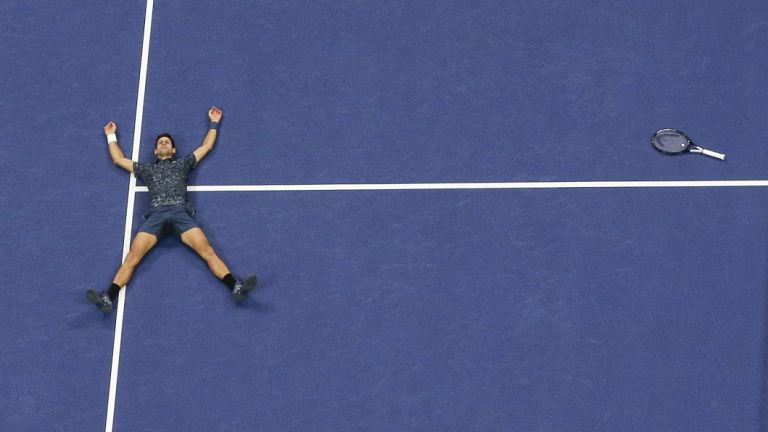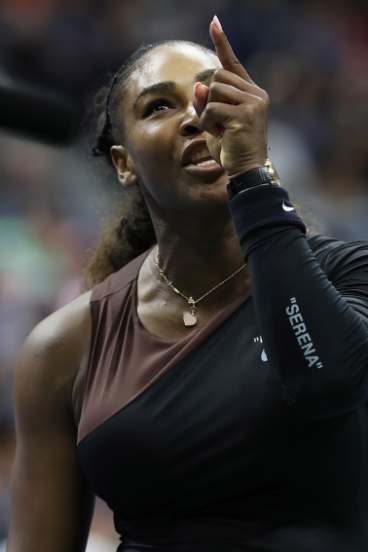Eleven-times French Open winner Spain’s Rafael Nadal bites the trophy.Credit:AP
The official tennis season ended in joy and thinly disguised rage last Sunday in the northern French city of Lille.
While Marin Cilic and the Croats celebrated their decisive 3-1 Davis Cup victory, French player Nicolas Mahut gave International Tennis Federation president David Haggerty an extended piece of his mind as he accepted his second-place prize, still angry at the decision to radically change the format of the men’s team competition next year.
Those seriously mixed emotions were an appropriate finish to a season in which tennis had much to celebrate (new stars like Naomi Osaka, enduring stars like Roger Federer and Serena Williams) but also much to lament as its governing bodies failed repeatedly to find common ground.
The sport’s leaders need to do better quickly in a brutally competitive global entertainment landscape where only full-strength events seem able to leave much of a trace.
Men’s tennis was not quite at full roar in 2018: Andy Murray, who finished No.1 in 2016, played only a handful of matches as he struggled to recover from hip surgery. The oft-injured Juan Martin del Potro had his most consistently successful season in nine years, only to fracture his right kneecap in Shanghai in October.
Rafael Nadal, 32, missed significant chunks of the season with various injuries and had to retire midmatch at the Australian Open and the US Open. But he still won five of the nine tournaments he did play, including the French Open for the 11th and likely not final time.
In the end, the top of the rankings had a throwback look. Novak Djokovic, 31, finished No.1 after a resurgence in the second half of the year, in which he won Wimbledon and the US Open. Nadal finished No.2, and Federer, 37, was No.3 despite again skipping the clay-court season.
King of New York: Novak Djokovic.Credit:AP
Those three enduring champions, who again hoarded the grand slam loot in 2018, were also the top three men in the rankings as far back as 2007. And they finished in exactly the same ranking order as recently as 2011.
‘‘What’s amazing to me is that they have been so successful in such a tough era where the professionalism in tennis had gone way beyond anything we’ve seen before,’’ said Darren Cahill, a long-time coach and analyst.
‘‘A lot of that is because of the money in the sport now and because everybody has the capability of putting a good team around them. Players are taking care of every aspect, ticking every box you can possibly tick, and yet these three guys have been able to dominate.’’
In a New York Times poll last month of ATP players, coaches and leading analysts, Djokovic, Nadal and Federer dominated the voting on the best shots in the game. Perhaps most remarkable: They finished 1-2-3 in the movement category despite all three being in their 30s.
‘‘That’s a tribute to how much emphasis they put on looking after their greatest asset, and that’s their body,’’ Cahill said.
Seven of the year-end top 10 are in their 30s, including 32-year-old South African Kevin Anderson and 33-year-old American John Isner, who both joined that elite group for the first time. Kei Nishikori, one of the game’s great ball strikers, also made a remarkable comeback from a major wrist injury to finish the year at No.9 at age 28.
But there were hints of an overdue generational shift. And if you consider the top 20, there are six players 23 or younger: Alexander Zverev, Karen Khachanov, Borna Coric, Kyle Edmund, Stefanos Tsitsipas and Daniil Medvedev. In all, the number of men in the top 100 age 30 or older dropped to 33 in 2018 from a record 43 last year.
Zverev, who now has the redoubtable Ivan Lendl on his coaching team, remains the undisputed leader of the new wave after winning the ATP Finals this month by defeating Federer and Djokovic back to back. But Zverev, ranked No. 4 at age 21, should have plenty of competition from his own generation. Khachanov, Coric and Tsitsipas are players of different styles who share the potential to win the biggest titles.
Khachanov, an imposing Russian with one of the heaviest forehands in the game, beat Zverev and Djokovic to win the Paris Masters event this month. Tsitsipas beat Djokovic, Zverev and Anderson on his way to the Toronto final this year. Coric, one of the game’s prime defenders but with an increasingly offensive mindset, beat Federer twice in 2018 and was a key member of the winning Croatian Davis Cup team.
For now, the grand slam titles that define careers (and earning power) remain the exclusive domain of the veterans. No active ATP player younger than 30 has won one of the four major singles titles, a first in the 50 years of the Open era.
The women’s game is in a far different, much less predictable place. Eight different women have won the last eight major singles titles, and five, including Simona Halep and Caroline Wozniacki in 2018, were first-time grand slam singles champions. Naomi Osaka won the US Open in September at 20, defeating Williams in straight sets in a final where Osaka’s nerveless brilliance was drowned out by Williams’ disputes with chair umpire Carlos Ramos.
Serena Williams argues with chair umpire Carlos Ramos.Credit:EPA
For the first time since 2006, Williams, 37, failed to win a tournament, but it was impossible to consider her comeback season from childbirth anything but a success. She also reached the Wimbledon final and won three rounds at the French Open impressively before withdrawing with a pectoral injury.
If Williams can stay healthy, she still has a fine chance to win another major and equal Margaret Court’s record of 24 grand slam singles titles. But Williams had best not tarry. Her older sister Venus faltered in 2018 after reaching two grand slam finals in 2017, dropping to No.38 in the rankings at age 38.
Osaka and other youngsters such as 20-year-old Belarusian Aryna Sabalenka have no shortage of power or ambition. Younger talents like Marta Kostyuk, 16; Amanda Anisimova, 17; and Dayana Yastremska, 18, are on the horizon.
And with another season over and another very soon to begin, it would be best if tennis’ leaders did not tarry, either. The sport’s divided governance remains the biggest obstacle to growth and a rational, sustainable schedule. Compromise should not be too much to ask.
If there are any doubts about the beauty of rapprochement, the bureaucrats should consider what happened after the Davis Cup final ended. Despite the disappointment, the French team visited the Croatian locker room and offered congratulations, embraces and eventually toasts.
New York Times
Source: Read Full Article


